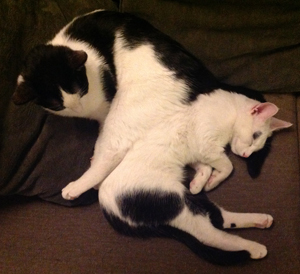Last fall, I posted, "12 things I learned from cancer." At the end, I included a poll: Which life lesson means the most to you? All of the tips got some votes, but the last one, number 12, has consistently come out ahead. Apparently, a lot of you can relate to the idea that we could do "a little bit less, a little bit better, and enjoy it all a whole lot more." When I wrote that, three months ago, I was in the last phases of eight months of exhausting cancer treatment. So yes, slowing down came with the territory. But now I want to retain that pace. Even as I write this sentence, I have to sit back and take a breath. It's not easy, going slow, even for someone still shaking the fatigue of chemo and the after-glow of radiation. Going slow -- doing less -- is against our societal grain. It's like a daily bit of radicalism.
As we engage with the activity of life, there is a constant flood of "stuff" to do and people to meet. It's exciting and important, but how do we keep up with everything AND slow down? There isn't one answer that fits for everyone. It depends on each of us -- our lives, energy, and responsibilities -- and it changes day by day. I don't have the answer, but I am engaged in the discovery. One thing I have learned is to do the best I can to listen to the signals my body gives me before they are drowned out in the busy-ness. Here are some other specific things that have helped in my journey. The first three deal with time and the next three with space. Skip around to find what interests you.
1. Quiet Time: I slow down for a bit every day, usually in the evening. When I teach late, I will create a pocket of down time in the morning instead. I do my walk or yoga around sunset and then turn off email and computers to relax with my husband and our four fabulous felines (yes, four, two arrived recently as a post-cancer surprise). I read a book or page through a magazine, cook a pot of soup or veggie chili, or watch something on TV. It's calm and peaceful and, for now, it's also necessary as I adjust to post-treatment fatigue. But as that improves, and I know it will day by day, I want to keep this relaxing time.
2. To-Do List Part 1 -- Categories: What I have found, pretty much all the time, is that there are more things in my to-do list than I can reasonably accomplish in any given day. To address this without constantly feeling behind, I took inspiration from a wise and kind social worker, one member of the excellent team at Norris Cancer Center, and divvied my tasks into groups -- for me, these include: teaching, writing, art, and home/personal. This last one is important; it's where I include vital things like: "Visit ashram with Diane," "Meet mom for lunch," or "Plan girls' outing," (if calling these vital seems odd, see life lesson #2 on my first list). Having my to-do list organized in this way helps me to stay balanced. I can mark accomplishments in the various spheres of my creative, professional, and home life without getting overwhelmed or over-emphasizing any one area.
3) To-Do List Part 2 -- Triage: This is one of my new favorites. I took a cue from my recent medical experiences and came up with what I call triage on the To-Do List. Here's how it works. When I see that there are more things on the list than I can accomplish in a dwindling time period, I locate the key items and disregard the rest, or leave them for another day. One way I decide whether the item is vital is how it will impact other people. For example, if I have writing I want to complete and also have a stack of papers to grade and students awaiting feedback, I choose the latter. With that comes another choice -- how I accomplish the task in the time given. One day, when pressed for time, I learned a good lesson. Unable to write extensive comments on a batch of student papers, I instead took 15 minutes at the start of class to talk one on one with each student about the work. This not only saved time, but proved more effective than my normally scrawled comments. To-do list triage has the added benefit of feeling great.
4) Lean Back: This is hands down the fastest way to slow down in any given moment! It's exactly what it sounds like and you can do it right now -- or anytime you like -- to gain a shift in perspective that never fails to invite a deep breath and an organic smile. Just lean back in your chair or stand slightly back on your heels. You can even do this with just your head in a pinch (or in a meeting): Slide your head ever so subtly back in space and notice how the rest of your body follows and softens. We tend to lead with our heads, literally, in this fast-paced, accomplishment-driven culture. Changing the view makes a world of difference.
5) Sky Mind: This one is inspired by meditations from teacher Sally Kempton. I adapted them to tune into spaciousness anywhere, anytime. Simply imagine your mind is the sky. Let all extraneous thoughts float in the luminous space of that sky. Let it be a blue cloudless one, a deep black starry sky, or a pink sunset, whatever you imagine in that moment. Sometimes, I watch as it shifts from one lovely sky to another. Rest your eyes and jaw and inner ears. This will generally inspire natural breath and a gradual smile. It can be done anywhere but avoid it while driving in case it shifts you from a calm mind into a deeper meditative state.
6) Let it Be: This is a wise tip I got several years ago from The Attitude Doc. Let it be replaces the more familiar, yet invariably nearly impossible mandate to "let it go." Instead, let it be. Okay, you say, I didn't finish this or that today. Or, okay, I really need to close my eyes for a minute. Or perhaps, okay, I am grumpy or tired or irritated or sore. The amazing thing about let it be is that, as soon as we accept uncomfortable feelings or situations and (if necessary or possible), address them, their impact decreases. Let it be will allow a deep sense of calm and facilitate a peaceful mind, which is the first step to slowing down.
I hope these help you do a little bit less a little bit better and enjoy it all a whole lot more. Please share your own tips for slowing down in the comments or find me on Facebook or Linked in. Happy sailing.


